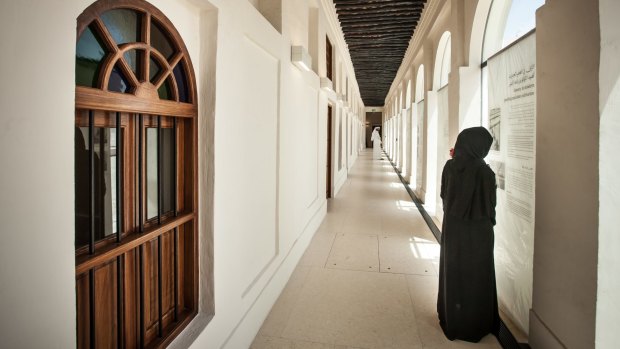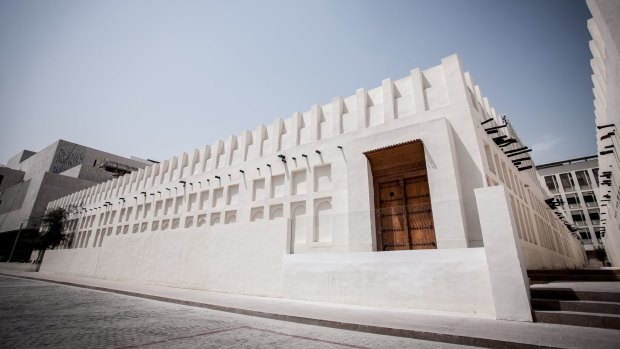This was published 4 years ago
In Doha, Qatar, a museum about the history of slavery can be unsettling
By David Whitley

A visit to Bin Jelmood House is thought-provoking.Credit: Jaber AlAzmeh
The artefacts make for an uncomfortable realisation. There's an amphora depicting enslaved workers from the height of Ancient Greece's power, a statue of a young Roman slave, shackles from a transatlantic slave ship. And it keeps going, until it clicks – most great human civilisations have been powered by slavery in some form.
Indeed, this building would not be here if it wasn't for slavery. Bin Jelmood House is one of four neighbouring heritage houses that have been turned into niche museums. Others in Doha's Msheireb Museums collection concentrate on oil, Qatari history and Qatari family life, but this former slave trader's home is the most arresting. Not least because there's considerably irony in having a slavery museum in Doha, given Qatar's alleged treatment of FIFA World Cup stadium workers.
Using projections, screens, signage and old photographs, it focuses on the centuries-old system around the Indian Ocean. It can be traced back to the Sumerian civilisation of the third millennium BC, and – unlike its transatlantic counterpart – has never been limited to a particular race, ethnicity or religion.

Bin Jelmood House is one of four neighbouring heritage houses that have been turned into niche museums.Credit: Msheireb Museums
Slave trading routes followed goods trading routes, and it was something of a free-for-all. Some were tricked or trapped into captivity, others prisoners of war, punished for a crime or forced into slavery to pay debts. In practice, this meant that slaves generally came from the poorest areas – traditionally Abyssinia and Nubia in Africa, then in the late 19th and early 20th century, Balochistan which is now a province of Pakistan.
It may not have been quite as systematic as the Western slave trade, but lucrative networks were in place. A person could be resold several times during the course of a land journey and raids and kidnapping were prevalent in conflict zones. Often traders based in ports would organise to have victims marched from hundreds of kilometres inland.
Two-thirds of slaves were women – many entered domestic servitude, others harems. But enslaved people filled a wide variety of roles, from administrators and entertainers to 20th century pearl divers. Some – the mamluks – even formed warrior castes and founded caliphates.
But an interesting point brought up is the lack of group consciousness. Unlike with the transatlantic system, in which slaves would work together on plantations or large labour projects, many Indian Ocean slaves were embedded in families and had little contact with others in their predicament.
Also thought-provoking is the role of Islam, which the museum sells as a positive force on the matter, even though it didn't forbid slavery. Kindness and manumission were encouraged, while slavery as punishment was banned and enslavement of Muslims was prohibited. Whether the enslaved people felt grateful for these new parameters is unaddressed.
One thing that is addressed, however, is modern-day slavery. Some of the statistics presented are stark: 2.5 million people are in forced labour as a result of trafficking and 1.2 million children are trafficked every year.
The walls hold images of enslaved sex workers in Cambodia, a nine-year-old girl working in an Indian brick factory and – perhaps more notably "workers having lunch in Doha".
The museum is very keen to talk about Qatar's National Strategy For Combating Human Trafficking and legislation outlawing child camel jockeys. But it also gives the briefest of nods to the kafala sponsorship system, regularly abused by unscrupulous employers in the Gulf states. Workers, who will often have taken out exorbitant loans from those promising them jobs in the Middle East, are then charged massive amounts for poor food and accommodation, while having their documents taken from them. In effect, they have no realistic way of leaving their job or going home.
This contractual enslavement, a critical element of the controversy over the 2022 FIFA World Cup stadium construction, is the elephant in the room. How it works is covered in detail. What is done to eradicate it from Qatar? Less so. And this doesn't half detract from what's otherwise a noble attempt to tackle an uncomfortable subject.
THE DETAILS
MORE
FLY
Qatar Airways flies direct to Doha from Sydney, Melbourne, Perth, Canberra and Adelaide. See qatarairways.com
STAY
Rooms at the nearby Mercure Grand hotel cost from 203 rial (A$80). See accorhotels.com
VISIT
Entry to the Msheireb Museums is free. See msheireb.com
David Whitley travelled at his own expense.
Sign up for the Traveller Deals newsletter
Get exclusive travel deals delivered straight to your inbox. Sign up now.